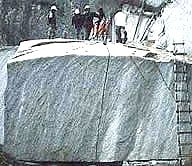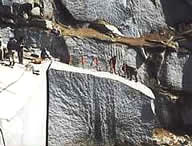Darda ROCK SPLITTERS
Granite - hydraulic splitters replace gunpowder


The Job:
At a quarry in Japan, white granite is quarried. Big blocks have to be broken out of the rock faces.
The Requirements:
Before the Darda method was introduced, the sides of the block were separated from the rock with thermal lances, after which the base was blasted free with gunpowder. This process produced blocks measuring
6 m x 6 m, which were then broken down into as many as eight smaller blocks, again with gunpowder. This method, however, entailed a number of major disadvantages, i.e.:
- It took three whole days to separate only one side of a block from the rock with a thermal lance.
- The lance method was far too heavy on fuel.
- The workers took a whole day to drill the holes for blasting a single block and another half-day to install the charges.
- Blasting with gunpowder was extremely dangerous.
- Hairline cracks frequently occurred, rendering the blocks unusable.
The Solution:
Two hydraulic rock and concrete splitters split granite blocks measuring 6 m long, 4-6 m high and 6 m wide. Each machine consists of four C 11 SL splitting cylinders, which are operated simultaneously, thereby developing a combined splitting force of over 1500 tons. In addition, the course of the split can be determined precisely in advance, the result being a dimensionally accurate granite block.
Following conversion to Darda splitters, the following advantages rapidly became evident:
- The drill-holes required to split a block were completed in only one hour.
- The splitters split out a granite block in only twenty minutes.
- The entire operation was considerably more productive. Many more blocks could be produced in less time.
- Hazardous situations became a thing of the past.
- Waste was virtually eliminated.
